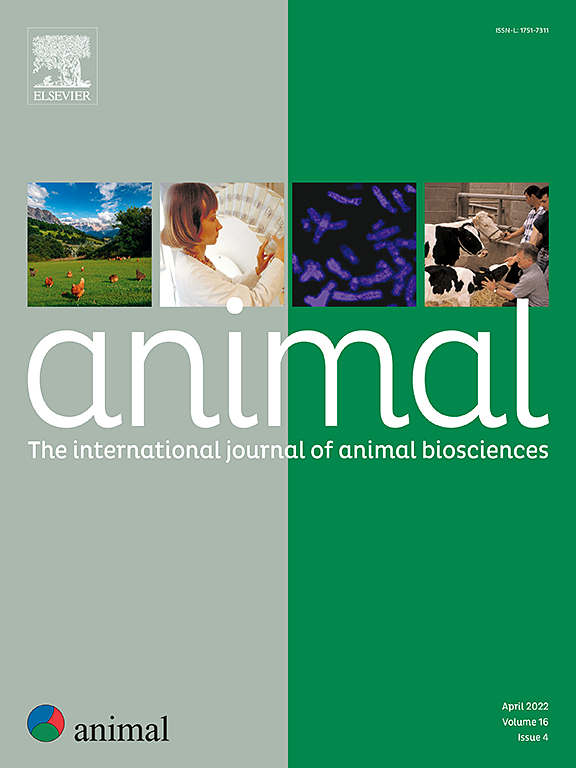不同理化性质的富含纤维成分调节猪的消化转运和消化动力学
IF 4
2区 农林科学
Q1 AGRICULTURE, DAIRY & ANIMAL SCIENCE
引用次数: 0
摘要
纤维的物理化学性质可以影响消化过程,如食糜运输,从而影响营养消化动力学。我们评估了(1)不同细胞壁组成和理化性质的不溶性纤维的影响;小麦秸秆(WS)、软木粉(WF)和葵花籽壳(SF),以及(2)在秸秆粗不溶性纤维(WSP)中添加果胶对猪消化部分的平均停留时间(MRT)和整个胃肠道营养物质消化(GIT)的影响。24头公猪(49.1±2.96 kg)分别饲喂4种饲粮,分别添加138 g/kg WF、144 g/kg SF和150 g/kg WS,其中高甲基化果胶不添加或添加100 g/kg高甲基化果胶。通过定量收集粪便评估营养物质的表观全消化道消化率。在饲喂添加示踪剂的日粮后,在频繁饲喂过程中对猪进行解剖,以接近食糜的稳态通道,并评估整个胃肠道中液体(Yb-EDTA)、细固体(TiO2)和不溶性纤维颗粒(铬介质纤维)的MRT。与粗WS不同,WSP的近端胃和远端胃之间的pH和DM没有差异,细WF和SF (P >;0.05)。与WS相比,WF和SF降低了细碎固体的MRT (- 01:51 ~ 01:03 h:min);P≤0.05),纤维颗粒(- 03:14 ~ 02:23 h:min;P≤0.05),减少了它们之间的分离,尤其是在远端胃(- 01:30 ~ 01:20 h:min;p≤0.05)。在WS中添加果胶减少了胃远端细固体和液体之间的分离(−43分钟;P≤0.05),提高了中小肠淀粉消化率(SI;+ 9%的单位;P≤0.05),但在SI结束时没有变化,并且全道氮消化率降低(- 8%-单位;P≤0.05),反映回肠消化率较低(- 8%-单位)。在大肠(LI)中,粗WS较细WF和SF降低了消化期的MRT(- 17:38至08:08 h:min)。无论来源如何,不溶性纤维的发酵较差(≤19%),而果胶的完全发酵不影响WS的发酵。综上所述,与粗秸秆相比,细麦麸和粗麦麸加速了胃内固体的排空,抑制了胃内pH的区域差异,并延迟了胃内的消化转运。在粗秸秆中添加果胶减少了胃在细固体和液体之间的筛分,提高了近端淀粉消化率。本文章由计算机程序翻译,如有差异,请以英文原文为准。
Fibre-rich ingredients differing in physicochemical properties modulate digesta transit and digestion kinetics in pigs
Physicochemical properties of fibres can affect digestive processes such as digesta transit, thereby affecting nutrient digestion kinetics. We evaluated the effects of (1) insoluble fibres differing in cell wall composition and physicochemical properties; wheat straw (WS), softwood flour (WF), and sunflower seed hulls (SF), and (2) addition of pectin to coarse insoluble fibres from straw (WSP), on the mean retention time (MRT) of digesta fractions and nutrient digestion throughout the gastrointestinal tract (GIT) of pigs. Twenty-four boars (49.1 ± 2.96 kg) were allocated to one of four diets, containing either 138 g/kg of WF, 144 g/kg of SF, or 150 g/kg of WS without or with the addition of 100 g/kg high-methylated pectin. The apparent total tract digestibility of nutrients was evaluated by quantitative faecal collection. After feeding diets supplemented with tracers, pigs were dissected following a frequent feeding procedure to approach steady-state passage of digesta, and assess MRT of liquids (Yb-EDTA), fine solids (TiO2), and insoluble fibrous particles (Chromium mordanted fibres) throughout the GIT. Unlike coarse WS, no differences in pH nor DM were observed between the proximal and distal stomach for WSP, and fine WF and SF (P > 0.05). Compared with WS, WF and SF reduced the MRT of fine solids (−01:51 to 01:03 h:min; P ≤ 0.05), and fibrous particles (−03:14 to 02:23 h:min; P ≤ 0.05) in the proximal and distal stomach, decreasing their separation, especially in the distal stomach (−01:30 to 01:20 h:min; P ≤ 0.05). Addition of pectin to WS reduced separation between fine solids and liquids in the distal stomach (−43 min; P ≤ 0.05), increased starch digestibility in the mid-small intestine (SI; +9%-units; P ≤ 0.05) but not at the end of the SI, and reduced total tract digestibility of nitrogen (−8%-units; P ≤ 0.05), reflecting a lower ileal digestibility (−8%-units). In the large intestine (LI), coarse WS reduced the MRT of digesta phases compared with fine WF and SF (−17:38 to 08:08 h:min). Regardless of origin, fermentation of insoluble fibres was poor (≤19%), while complete fermentation of pectin did not impact the fermentation of WS. In conclusion, fine WF and SF accelerated the emptying of solids and suppressed regional differences in pH in the stomach, and delayed digesta transit in the LI, compared with coarse straw. Pectin addition to coarse straw reduced gastric sieving between fine solids and liquids, and increased starch digestibility in the proximal SI.
求助全文
通过发布文献求助,成功后即可免费获取论文全文。
去求助
来源期刊

Animal
农林科学-奶制品与动物科学
CiteScore
7.50
自引率
2.80%
发文量
246
审稿时长
3 months
期刊介绍:
Editorial board
animal attracts the best research in animal biology and animal systems from across the spectrum of the agricultural, biomedical, and environmental sciences. It is the central element in an exciting collaboration between the British Society of Animal Science (BSAS), Institut National de la Recherche Agronomique (INRA) and the European Federation of Animal Science (EAAP) and represents a merging of three scientific journals: Animal Science; Animal Research; Reproduction, Nutrition, Development. animal publishes original cutting-edge research, ''hot'' topics and horizon-scanning reviews on animal-related aspects of the life sciences at the molecular, cellular, organ, whole animal and production system levels. The main subject areas include: breeding and genetics; nutrition; physiology and functional biology of systems; behaviour, health and welfare; farming systems, environmental impact and climate change; product quality, human health and well-being. Animal models and papers dealing with the integration of research between these topics and their impact on the environment and people are particularly welcome.
 求助内容:
求助内容: 应助结果提醒方式:
应助结果提醒方式:


